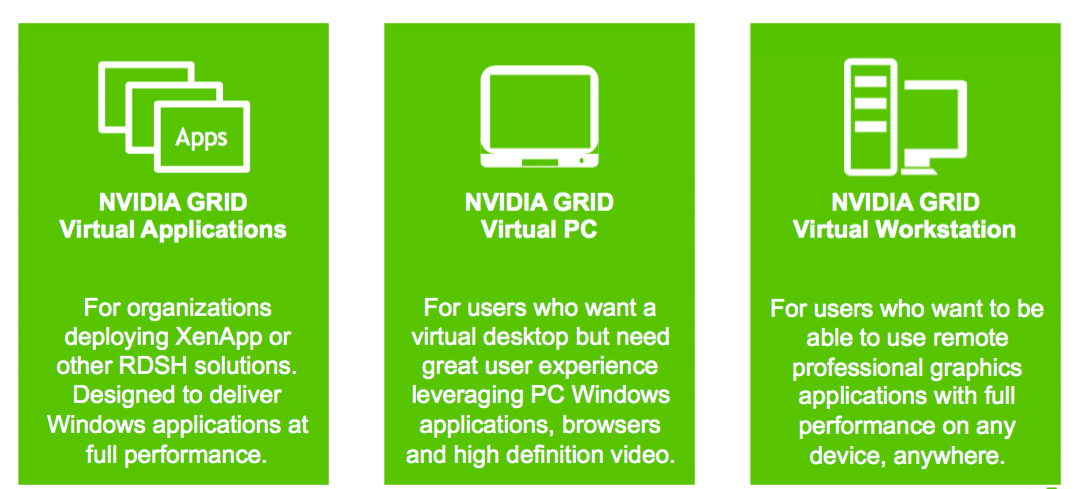 Today NVIDIA announced the latest version of its NVIDIA GRID software as well as a its newest GPU, the Tesla M10. Along with this announcement, NVIDIA is boldly stating that this will open the path toward virtualizing all enterprise applications. In order to deliver virtualized apps to all of their employees at an affordable cost, organizations can leverage the Tesla M10 which has the highest user density per board at 64 users.
Today NVIDIA announced the latest version of its NVIDIA GRID software as well as a its newest GPU, the Tesla M10. Along with this announcement, NVIDIA is boldly stating that this will open the path toward virtualizing all enterprise applications. In order to deliver virtualized apps to all of their employees at an affordable cost, organizations can leverage the Tesla M10 which has the highest user density per board at 64 users.
Today NVIDIA announced the latest version of its NVIDIA GRID software as well as a its newest GPU, the Tesla M10. Along with this announcement, NVIDIA is boldly stating that this will open the path toward virtualizing all enterprise applications. In order to deliver virtualized apps to all of their employees at an affordable cost, organizations can leverage the Tesla M10 which has the highest user density per board at 64 users.

A few years ago the thought of office workers heavily relying on GPU-accelerated applications would have seemed absurd, however it is quickly becoming a reality. According to SysTrack Community data provided by Lakeside Software, GPU-accelerated apps have more than doubled in the past five years with half of the growth happening in 2016 alone. These applications are increasingly using OpenGL and DirectX APIs to provide the best user experience. In order to hit the level of performance required by users, virtual environments need access to the GPU.
NVIDIA GRID is thought of by some as the industry standard for graphics virtualization. GRID is supported by most if not all enterprise OEMs and PC applications. GRID enables companies to simplify deployments of virtual applications, desktops and workstations to meet all use cases and workloads. The latest version of GRID offers flexible subscription models to aid in enterprise adoption of virtualized applications. NVIDIA is working with Citrix and VMware to deliver better experiences with virtual applications or remote desktop session hosts for less than $2 a month per user and to virtual PCs for less than $6 a month per user.
The Tesla M10 completes NVIDIA’s line of GPUs, including M6 and M60, helping to make GRID meet performance needs of all enterprise users, from engineers and designs down to someone using a photo editing program for presentations. The M10 is aimed more for a larger number of users while the M6 and M60 is aimed at higher performance needs.
Benefits include:
- Increased user density per server: The Tesla M10 delivers the highest user density on the market, allowing up to 64 users per board or up to 128 users per server with two boards. This enables enterprises to expand service to more employees at a lower cost per user.
- Expanded software offering: NVIDIA GRID comes in three software editions to meet different user needs. For office workers, NVIDIA Virtual Applications (vApps) and NVIDIA Virtual PC (vPC) deliver Windows 7, Windows 8 and Windows 10 virtual desktops and PC applications with native user experience. NVIDIA Virtual Workstation (vWS) delivers the power of a workstation from the data center, so designers, engineers and architects are free to work on their professional graphics applications from anywhere.
- Flexible subscription model, ongoing updates: To ease adoption, NVIDIA is offering a new annual subscription model that offers customers access to the latest upgrades along with enterprise-class support and maintenance. Customers can buy up to three years of annual subscription upfront. Alternatively, they can choose the perpetual license model.
Availability
The latest version of NVIDIA GRID software is available today. The NVIDIA Tesla M10 GPU is expected to be available in August 2016.
Sign up for the StorageReview newsletter
